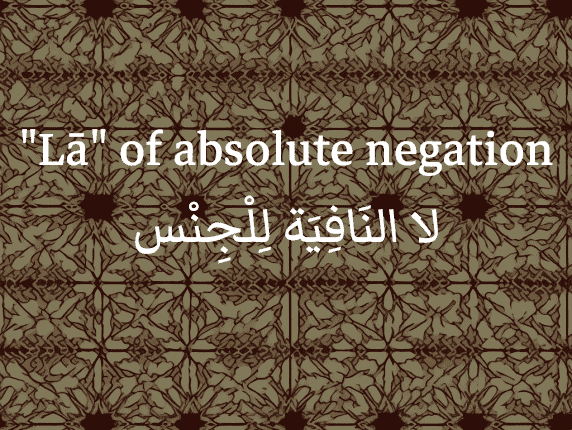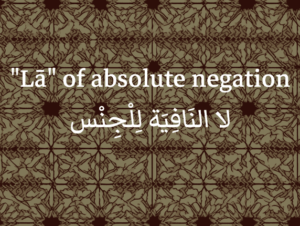“Lā” of absolute negation / لا النافِية للجِنْس

Definition
In Arabic, there are different types of “lā” (لا) as a negating particle, two of which are used with a verb in the imperfect tense (مُضارِع) (see dedicated pages). The other type is the lā of absolute negation in Arabic, which is only used to negate the nominal sentence and mark the absolute nonexistence of a being or thing. It puts the noun (the subject) in the accusative case like ‘Inna and its sisters’, but without a definite article (أَداة التَعْرِيف) or nunation (تَنْوِين).
In other words, the word it relates to will end with a single fatḥa (without tanwīn) and will never bear the definite article ال. This is one of the very rare situations where a noun remains defined even though it has neither an article nor an attached complement.
| No one is here | لاَ أَحَدَ هُنَا |
| No country is better than ours | لا بَلَدَ أَفْضَلُ مِن بَلَدِنا |
| I have no knowledge of that | لاَ عِلْمَ لِي بِذَلِكَ |
Note: If it is preceded by a preposition, then it will have no grammatical effect and function as an ordinary negating particle. The noun that follows the particle should be in its genitive form due to the preceding preposition (حَرْف جَرّ).
غادَرْتُ بِلا شَيْءٍ I left with nothing
Note 2: If the noun is followed by an adjective, the said-adjective of the negated noun will be in the accusative form:
لا فُرْصةَ مُتاحةً لَهُم They have (absolutely) no opportunity
The difference with regular negation
The lā of absolute negation (لا النافية للجِنْس) is different from /lā/ of regular negation which negates the oneness and doesn’t indicate the absolute nonexistence of a being or thing. This latter implies that the said object or thing could exist but isn’t present at the time of enunciation. It also intervenes in the nominal sentence but without any grammatical effect.
| لا النافية للجِنْس Lā of absolute negation | لا النافِي Lā of regular negation |
|---|---|
| لا حَلَّ لهذه المُشْكِلة | لا حَلٌّ لهذه المُشْكِلة |
| There is not a single solution to this problem | There is no solution to this problem |
Some contexts of use
This construction will often be followed by إِلاّ as in the two following religious formulas:
| There is (absolutely) no power but from God | لا حَوْلَ وَلا قُوَّةَ إلا بِاللّهِ |
| No God [can ever exist] except Allah | لا إلهَ إِلا اللّهُ |
This construction can also be found in many common expressions:
| No objection | لا مانِعَ |
| No escape (used meaning “must”) | لا بُدَّ |
| Nothing | لا شَيْءَ |
| No one | لا أَحَدَ |
| No harm (used meaning “that’s fine”) | لا بأْسَ |
| No doubt | لا شَكَّ |
"Lā" of absolute negation

Learn about the "Lā" of absolute negation in Arabic and how it functions in negating entire sentences. Find explanations, examples, and more in our comprehensive guide.
Course Provider: Organization
Course Provider Name: ArabiKey
Course Provider URL: https://arabikey.com
5

Responses